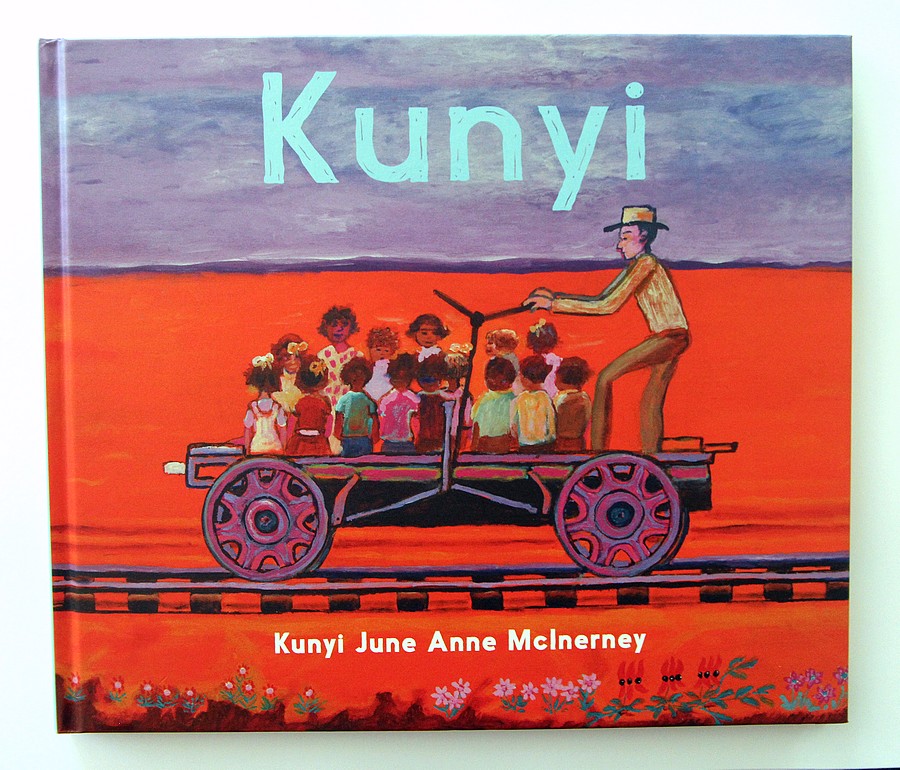
‘Kunyi’ by Kunyi June Anne McInerney tells her story in this picture book about being forcibly removed from her family and home when she was four years old to live with the missionaries at the Oodnadatta Children’s Home in the 1950s. This is a story of dispossession, loss, fear, courage, resilience and friendship. Kunyi tells this story through a written account, detailing her experiences of what it was like living at the Children’s Home and includes her vibrant art to illustrate these memories. Over sixty of Kunyi’s paintings are included in this book that were part of the ‘My Paintings Speak for Me’ exhibition.
Kunyi begins her story with her family – her mother, granny and siblings. Together, they peacefully and happily lived in a humpy where they spoke the Yankunytjatjara language.
Kunyi explains that when she went to the Oodnadatta Children’s Home her name was changed to ‘Anne’ and she was told to speak English. The home was rudimentary and lacking any creature comforts. There was no insulation, given it was in the desert, it was unbearably hot in the summer and freezing cold in winter. There was no dining room, the children ate out on the verandah under a corrugated iron roof. The children slept on beds covered in sets of rags, no sheets, just rags. Clean bath water was unheard of as all children bathed in the same, unchanged bathwater. They knew no different. There was no toilet paper, pieces of newspaper were used.
Kunyi shares her recollection of the children working in silence as their job was to peel the vegetables. She talks about the older children taunting the younger children by telling them about Mamu (bad spirits) while they ate their dinner on the dark verandah. Kunyi mentions the compulsory Bible lessons where harsh punishments were given if it was deemed you were not paying attention. As there were no toys or games for the children to play with, they employed their creativity and resourcefulness to make their own. Treasure came in the form of broken crockery, especially the ones featuring beautiful designs and these were hidden away from the Sisters. There were some treasured times too when the children would look for animal bones and suck the bone marrow, or go swimming at Hookey’s Hole. Kunyi’s artworks deftly capture the freedom and joy the children experienced when they were away from the home and swimming, walking along the gibber stones or admiring the wildflowers and eating bush tucker. Their admiration for the land and profound connection to it is palpable in the artwork. Kunyi talks about the harsh and cruel punishments and how the children were highly controlled and frequently punished. The final parts of her story tell how Kunyi came to leave the children’s home at age nine, after five years of being there, it was cruel, deceitful and done without care or compassion. Kunyi was sent away to a foster family who changed her name to ‘June’. Kunyi then shares a little about her mother’s heartbreaking story. There are personal photos from Kunyi’s private collection of her and her siblings at the home and later in life that have been included at the back of the book.
The end papers are truly a sight to behold, they feature a montage containing a piece from each of the paintings in the book. Each artwork represents a memory or experience, one part of Kunyi’s story. The endpapers resemble a classic squares quilt with each square a piece of Kunyi’s heart and story.
Kunyi’s story about the way the children in the home were torn away from their families, stripped of their identities, forced to reject their culture and adopt a white culture have been shared so people can learn what happened and so the children’s experiences while at the Oodnadatta Children’s Home will not be forgotten. Kunyi has opened her heart to tell her story and that of the children in the home to educate and inform others about the long-lasting intergenerational impact of the Stolen Generations.
